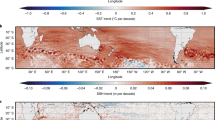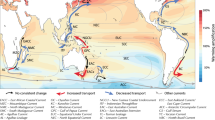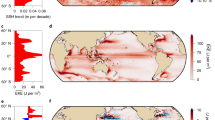Abstract
Subtropical western boundary currents are warm, fast-flowing currents that form on the western side of ocean basins. They carry warm tropical water to the mid-latitudes and vent large amounts of heat and moisture to the atmosphere along their paths, affecting atmospheric jet streams and mid-latitude storms, as well as ocean carbon uptake1,2,3,4. The possibility that these highly energetic currents might change under greenhouse-gas forcing has raised significant concerns5,6,7, but detecting such changes is challenging owing to limited observations. Here, using reconstructed sea surface temperature datasets and century-long ocean and atmosphere reanalysis products, we find that the post-1900 surface ocean warming rate over the path of these currents is two to three times faster than the global mean surface ocean warming rate. The accelerated warming is associated with a synchronous poleward shift and/or intensification of global subtropical western boundary currents in conjunction with a systematic change in winds over both hemispheres. This enhanced warming may reduce the ability of the oceans to absorb anthropogenic carbon dioxide over these regions. However, uncertainties in detection and attribution of these warming trends remain, pointing to a need for a long-term monitoring network of the global western boundary currents and their extensions.
This is a preview of subscription content, access via your institution
Access options
Subscribe to this journal
Receive 12 print issues and online access
$209.00 per year
only $17.42 per issue
Buy this article
- Purchase on Springer Link
- Instant access to full article PDF
Prices may be subject to local taxes which are calculated during checkout



Similar content being viewed by others
References
Minobe, S., Kuwano-Yoshida, A., Komori, N., Xie, S-P. & Small, R. J. Influence of the Gulf Stream on the troposphere. Nature 452, 206–209 (2008).
Kwon, Y-O. et al. Role of Gulf Stream, Kuroshio-Oyashio and their extensions in large-scale atmosphere–ocean interaction: A review. J. Clim. 23, 3249–3281 (2010).
Nakamura, H., Sampe, T., Tanimoto, Y. & Shimpo, A. in Earth’s Climate: The Ocean-Atmosphere Interaction (eds Wang, C., Xie, S-P. & Carton, J. .A.) 329–346 (Geophysical Monograph Series, Vol. 147, AGU, 2004).
Takahahi, T. et al. Climatological mean and decadal change in surface ocean pCO2 and net sea–air CO2 flux over the global oceans. Deep-Sea Res. 56, 554–577 (2009).
Roemmich, D. Super spin in the southern seas. Nature 449, 34–35 (2007).
Beal, L. M., De Ruijter, W. P. M., Biastoch, A., Zahn, R. & SCOR/WCRP/IAPSO Working Group 136, On the role of the Aguhlas system in ocean circulation and Climate. Nature 472, 429–436 (2011).
Saenko, O. A., Fyfe, J. C. & England, M. H. On the response of the oceanic wind-driven circulation to atmospheric CO2 increase. Clim. Dynam. 25, 415–426 (2005).
Meehl, G. et al. The WCRP CMIP3 multimodel dataset: A new era in climate change research. Bull. Am. Meteorol. Soc. 88, 1383–1394 (2007).
Levitus, S. et al. Anthropogenic warming of earth’s climate system. Science 292, 267–270 (2001).
Sutton, R. & Hodson, D. Climate response to basin-scale warming and cooling of the North Atlantic Ocean. J. Clim. 20, 891–907 (2007).
Xie, S. P. et al. Global warming pattern formation: Sea surface temperature and rainfall. J. Clim. 23, 966–986 (2010).
Cane, M. A. et al. Twentieth-century sea surface temperature trends. Science 275, 957–960 (1997).
Collins, M. & CMIP Modelling Groups, El Niño-or La Niña like climate change? Clim. Dynam. 24, 89–104 (2005).
Vecchi, G. A. & Soden, B. J. Global warming and the weakening of the tropical circulation. J. Clim. 20, 4316–4340 (2007).
Deser, C., Phillips, A. & Alexander, M. Twentieth century tropical sea surface temperature trends revisited. Geophys. Res. Lett. 37, L10701 (2010).
Seager, R., Kushnir, Y., Naik, N. H., Cane, M. A. & Miller, J. Wind-driven shifts in the latitude of the Kuroshio–Oyashio Extension and generation of SST anomalies on decadal timescales. J. Clim. 14, 4249–4265 (2001).
Marshall, J., Johnson, H. & Goodman, J. A study of the interaction of the North Atlantic Oscillation with ocean circulation. J. Clim. 14, 1399–1421 (2001).
Cai, W. et al. The response of the Southern Annular Mode, the East Australian Current, and the southern mid-latitude ocean circulation to global warming. Geophys. Res. Lett. 32, L23706 (2005).
Joyce, T. M. & Schmitz, W. J. Zonal velocity structure and transport in the Kuroshio Extension. J. Phys. Oceanogr. 18, 1484–1491 (1988).
Fu, Q., Johanson, C. M., Wallace, J. M. & Reichler, T. Enhanced mid-latitude tropospheric warming in satellite measurements. Science 312, 1179 (2006).
Gillett, N. & Thompson, D. Simulation of recent Southern Hemisphere climate change. Science 302, 273–275 (2003).
Lu, J., Vecchi, G. A. & Reichler, T. Expansion of the Hadley cell under global warming. Geophys. Res. Lett. 34, L06805 (2007).
Cunningham, S. A. et al. Temporal variability of the Atlantic Meridional Overturning Circulation at 26.5° N. Science 317, 935–938 (2007).
Rayner, N. et al. Globally complete analyses of sea surface temperature, sea ice and night marine air temperature since the late nineteenth century. J. Geophys. Res. 108, 4407 (2003).
Smith, T. M. et al. Improvements to NOAA’s historical merged land–ocean surface temperature analysis (1880–2006). J. Clim. 21, 2283–2296 (2008).
Kaplan, A. et al. Analyses of global sea surface temperature 1856–1991. J. Geophys. Res. 103, 18,567–18,589 (1998).
Giese, B. S. & Ray, S. El Niño variability in simple ocean data assimilation (SODA), 1871–2008. J. Geophys. Res. 116, C02024 (2011).
Rayner, N. et al. Improved analyses of changes and uncertainties in sea surface temperature measured in situ since the mid-nineteenth century: The HadSST2 data set. J. Clim. 19, 446–469 (2006).
Minobe, S. & Maeda, A. A 1 degree SST dataset compiled from IOCADS from 1850 to 2002 and Northern Hemisphere frontal variability. Int. J. Climatol. 25, 881–994 (2005).
Bohan, P., Kennedy, J., Harris, I., Tett, S. & Hones, P. Uncertainty estimates in regional and global observed temperature changes: A new dataset from 1850. J. Geosphys. Res. 111, D12106 (2006).
Compo, G. P. et al. The Twentieth Century Reanalysis Project. Q. J. R. Meteorol. Soc. 137, 1–28 (2011).
Tokinaga, H. & Xie, S-P. Wave and Anemometer-based Sea-surface Wind (WASWind) for climate change analysis. J. Clim. 24, 267–285 (2011).
Acknowledgements
This work is supported by China National Key Basic Research Project (2007CB411800) and National Natural Science Foundation Projects (40788002, 40930844, 40921004). W.C. is supported by the Australian Climate Change Science program and the Southeast Australia Climate Initiative. H.N. is supported in part by the Japanese Ministry of Education, Culture, Sports, Science and Technology through Grant-in-Aid for Scientific Research on Innovative Areas #2205 and by the Japanese Ministry of Environment through Global Environment Research Fund (S-5). M.J.M. is supported by the National Oceanic and Atmospheric Administration’s Climate Program Office. PMEL Publication no. 3774.
Author information
Authors and Affiliations
Contributions
L.W. and W.C. contributed the central idea and wrote the initial draft of the paper. L.Z. performed data analyses. The remaining authors contributed to refining the ideas and to writing this paper.
Corresponding author
Ethics declarations
Competing interests
The authors declare no competing financial interests.
Supplementary information
Rights and permissions
About this article
Cite this article
Wu, L., Cai, W., Zhang, L. et al. Enhanced warming over the global subtropical western boundary currents. Nature Clim Change 2, 161–166 (2012). https://doi.org/10.1038/nclimate1353
Received:
Accepted:
Published:
Issue Date:
DOI: https://doi.org/10.1038/nclimate1353
This article is cited by
-
Interactions between cold cyclonic eddies and a western boundary current modulate marine heatwaves
Communications Earth & Environment (2023)
-
Satellite-observed strong subtropical ocean warming as an early signature of global warming
Communications Earth & Environment (2023)
-
Northward shift of the Kuroshio Extension during 1993–2021
Scientific Reports (2023)
-
Recent increases in tropical cyclone rapid intensification events in global offshore regions
Nature Communications (2023)
-
Warming and lateral shift of the Gulf Stream from in situ observations since 2001
Nature Climate Change (2023)



